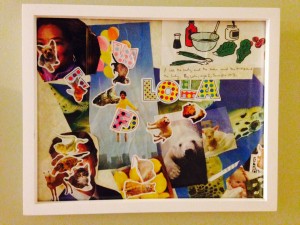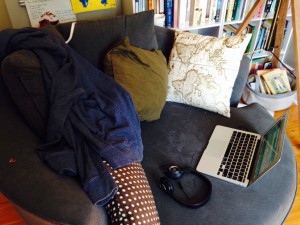Bestselling author ALICE KUIPERS was born in London. She moved to Canada in 2003. Her first novel, Life on the Refrigerator Door, was published in 28 countries and won several awards. Since then, she has published two further award-winning YA novels internationally, with a fourth, The Death of Us, released earlier this month. Alice has three small children and she began writing picture books for them. Her first picture book, Violet and Victor Write The Best Ever Bookworm Book, will be published in December this year. Alice’s website is full of tips and hints for those of you who want to become writers too. Find her here: www.alicekuipers.com, or on Twitter, Facebook, or Goodreads. The Death of Us Blog Tour started September 2: #DeathofUsBT
Here is Alice’s contribution, with a twist, to my Seven Treasures memoir series.
I don’t like stuff. It weighs me down. I regularly go through the objects in my house and put them into various boxes: to donate, to chuck, to gift. When I look at piles of things, I feel cluttered inside, stressed out, and I find myself removing, tidying, emptying. There’s an essay by E.B. White where he talks about how stuff clings. He writes, “Under ordinary circumstances, the only stuff that leaves a home is paper trash and garbage; everything else stays on and digs in.”
The idea of my belongings “digging in” alarms me, frankly, so thinking of seven treasures isn’t easy. It makes me want to gather those things immediately and cast them off, let them go, lighten and be free.
Yet there are seven things that come to mind.
The ring on the thumb of my right hand, for instance. It was made for me at a silver-making workshop in Hong Kong by my boyfriend at the time. I’ve worn it ever since and it reminds me of what we had together, a life full of anticipation, excitement, and travel, a life that didn’t hold conversations about kindergarten drop-off times or running out of diapers. That ex and I don’t really speak anymore although ostensibly we’re friends. And I know he no longer wears his ring. A moment that is treasured by me, means nothing to him. Stuff takes on the meaning we give to it.
The other day, I found in a jacket pocket the plastic wristband the hospital gave me when my third son was born. It has on it his birthday and my name, but not his. He wasn’t yet named, this lively, curly-haired creature who fills my waking moments and who interrupts my sleep. For now I will keep this wristband as a reminder of when my youngest child came squalling into the world.
From each of my other two children, I have artwork that I treasure. Out of the piles of crafts that I keep haphazardly behind the comfy chair in my office, two pieces have been rescued and hung. One is by my eldest, painted when he was so little he could hardly hold a paintbrush. He called it “PAINTING MUMMY.” I am already nostalgic for his babyhood.
 A collage by my daughter hangs in the hall, full of pictures she selected and glued. Again, as I look at it memories resurface. It’s strange to feel nostalgic even as my floppy-puppy-heap of children come tumbling into my office interrupting my attempts to write this — but that’s the power of objects. They can take you back, help you remember, stir up emotions (sometimes ones that you’d prefer to ignore).
A collage by my daughter hangs in the hall, full of pictures she selected and glued. Again, as I look at it memories resurface. It’s strange to feel nostalgic even as my floppy-puppy-heap of children come tumbling into my office interrupting my attempts to write this — but that’s the power of objects. They can take you back, help you remember, stir up emotions (sometimes ones that you’d prefer to ignore).
I’m sitting in that comfy office chair I just mentioned and realize the chair itself is another treasure. It’s a strange shape, round and big enough for me as well as at least two children and my laptop. When we bought it, my boyfriend insisted I’d never use it. But I write in it nearly every day. My YA novel that’s just coming out was edited from here. My picture books were written as I curled up like a cat in this spot. Although I can write anywhere, there’s something special about this chair.
Next to me on the chair is a fleecy hooded sweater, a “bunny hug,” as we call them in Saskatchewan. I bought it recently on a trip to the UK and I know when I wear it that I look scruffy, but I can’t stop. It’s warm, fuzzy on the inside, and so ridiculously comfortable that I find myself seeking it out as soon as I wake. Throughout my life, I’ve treasured items of clothing that I’ve worn fairly constantly for periods of time, until the piece wore right out. Or was lost. One reason that I try to separate from my stuff is that I’m always losing things. I fall in love with an object only to forget it at someone’s house or leave it on a plane. I’m so disorganized and messy that I’m not sure beautiful things should be in my possession. Perhaps this “bunny hug” isn’t beautiful to anyone else, but right now I treasure it.
 My quest for the final treasure of my seven treasures takes me back once again in my imagination to Hong Kong. There, a friend gave me a box of cards, each bearing a couple of words. They were created by Brian Eno as a tool for creativity. The friend asked nothing from me; he just thought I’d like the gift. I was touched by the gesture. I still am. I love to look at the black box and the words OBLIQUE STRATEGIES written in gold. I rarely open the box, but just knowing it’s there pleases me. I brought it with me back to the UK and then successively to each of our four houses in Saskatoon. For someone who doesn’t like stuff very much, this box has a way of sticking around. It has dug in.
My quest for the final treasure of my seven treasures takes me back once again in my imagination to Hong Kong. There, a friend gave me a box of cards, each bearing a couple of words. They were created by Brian Eno as a tool for creativity. The friend asked nothing from me; he just thought I’d like the gift. I was touched by the gesture. I still am. I love to look at the black box and the words OBLIQUE STRATEGIES written in gold. I rarely open the box, but just knowing it’s there pleases me. I brought it with me back to the UK and then successively to each of our four houses in Saskatoon. For someone who doesn’t like stuff very much, this box has a way of sticking around. It has dug in.
 Those are seven treasures. But really, I could have chosen so many other things. Because much as I try to be all Zen, to move lightly and let go, sometimes those feelings of nostalgia and even sadness, the memories of a bar in Hong Kong or a birth in a hospital in Saskatoon, need to be revisited. None of these objects mean very much to anyone else, and I suspect at some point each will leave me and end up donated, thrown out, or gifted, but right now each of them — the cozy sweater, the big armchair, the quiet black box, and the rest — tethers me both to the past and also to the life I’m living now, one full of children, writing, and art.
Those are seven treasures. But really, I could have chosen so many other things. Because much as I try to be all Zen, to move lightly and let go, sometimes those feelings of nostalgia and even sadness, the memories of a bar in Hong Kong or a birth in a hospital in Saskatoon, need to be revisited. None of these objects mean very much to anyone else, and I suspect at some point each will leave me and end up donated, thrown out, or gifted, but right now each of them — the cozy sweater, the big armchair, the quiet black box, and the rest — tethers me both to the past and also to the life I’m living now, one full of children, writing, and art.
For more posts in the Seven Treasures series, please click here.

I admire in particular the phrase “but right now I treasure it” — captures honestly the transitory side of keep-saking.